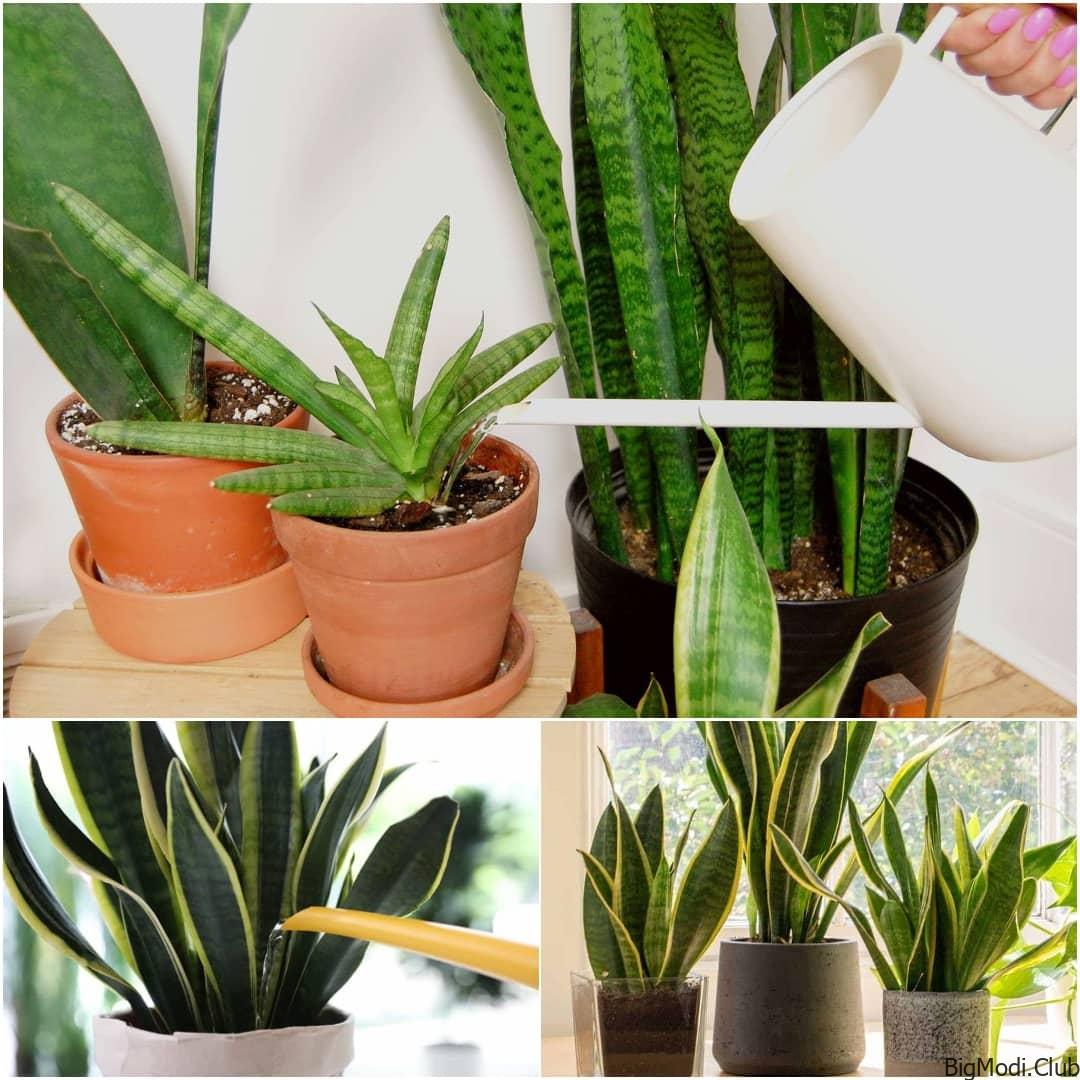Snake plants are one of the easiest plants to care for, but understanding how often to water them can make a big difference in their health and appearance. While these tough plants can survive neglect, watering them correctly ensures they thrive and continue to add beauty to your home or garden.
How Often to Water Snake Plant
Snake plants, also known as Dracaena trifasciata or Sansevieria, are popular houseplants due to their resilience and low maintenance needs. However, even though they are nearly indestructible, getting their watering schedule right is crucial for keeping them healthy. In this article, I’ll guide you through the details of how often to water your snake plant, considering factors like seasons, light, temperature, and growing conditions.
Why Snake Plants Are Drought-Tolerant
Snake plants are classified as succulents, meaning they store water in their thick, fleshy leaves. This water storage helps them survive long periods without moisture, making them extremely drought-tolerant. Originating from arid regions in Africa and Southern Asia, these plants have adapted to survive in harsh conditions where water is scarce.
When to Water a Snake Plant
The general rule for watering a snake plant is to water it when the soil is completely dry. Overwatering is the most common mistake people make with snake plants, as these plants are more susceptible to root rot than other houseplants. Here’s how you can time your watering to keep your snake plant healthy:
How to Tell if Snake Plant Needs Water
When it comes to caring for your snake plant, determining when it needs water can sometimes be tricky. Too little or too much water can both cause problems for your plant. Below are the signs you should look for to know whether your snake plant is thirsty or overwatered.
Signs Your Snake Plant is Underwatered
Underwatering is common with snake plants, as they are drought-tolerant. However, even these hardy plants need water, and there are clear signs when they’re not getting enough.
- Wilted, Wrinkling Foliage: One of the first indicators of underwatering is when the leaves start to wilt or wrinkle. They may also droop, signaling the plant’s lack of moisture.
- Fading, Yellowing, or Crispy Leaves: If the leaves are changing color—turning yellow, brown, or becoming crispy—it’s a strong sign that the plant is dehydrated.
- Hard, Compact Soil: Another clue is the soil itself. If the soil feels hard, compact, or appears lighter in color, especially beneath the surface, it’s time to water your snake plant.
If these signs appear, increase the watering frequency slightly to bring the plant back to health.
Signs Your Snake Plant is Overwatered
Surprisingly, overwatering is even more dangerous for snake plants than underwatering. Since they’re drought-tolerant, too much moisture can cause root rot and other serious issues.
- Squishy, Drooping Leaves: While drooping leaves can be a sign of underwatering, they can also indicate overwatering. The difference lies in the texture—overwatered leaves will feel soft, squishy, or moist.
- Yellowing Leaves: If your snake plant has been overwatered for a long time, its leaves may start to yellow. This can also happen with underwatering, so it’s essential to assess other symptoms too.
- Soggy Soil and Mold: Overwatered soil will look dark, soggy, and might even develop white mold patches. You may also spot fungus gnats, which thrive in overly moist environments.
If you notice these symptoms, reduce watering immediately and check for root rot.
Snake Plant Watering Schedule
Spring and Summer Watering Schedule
During the growing seasons (spring and summer), snake plants need more frequent watering due to increased light exposure and higher temperatures. Generally, you should water your snake plant once a week during these seasons. However, the watering frequency may vary depending on your plant’s location and the surrounding environmental conditions.
Fall and Winter Watering Schedule
In the fall and winter months, snake plants enter a period of dormancy, and their water requirements decrease significantly. You may only need to water your snake plant once every two to three weeks during these colder months, as the plant’s growth slows down and its need for water diminishes.
Watering Snake Plants Indoors vs. Outdoors
Indoor Snake Plant Watering Needs
Indoor snake plants are typically protected from extreme environmental conditions, but their watering needs will still vary based on the room’s light exposure and temperature. A plant in a well-lit room with higher temperatures will require more frequent watering than one in a cooler, darker room.
Outdoor Snake Plant Watering Considerations
If you grow snake plants outdoors, particularly in climates where temperatures stay above 55°F year-round, you’ll need to water them more regularly. Outdoor plants exposed to direct sunlight and warmer conditions may dry out faster, requiring weekly watering during the summer.
Light and Its Effect on Watering Frequency
The amount of light your snake plant receives plays a crucial role in how often it needs water. Plants growing in bright, indirect light will need more frequent watering than those placed in low-light conditions. Snake plants can adapt to various lighting conditions, but their water needs should be adjusted accordingly.
Temperature and Humidity Considerations
Higher temperatures increase a plant’s water needs, while lower temperatures slow down water evaporation from the soil. Similarly, high humidity levels reduce the frequency of watering, while dry, hot climates will require you to water more often. Always take these factors into account when deciding on your snake plant’s watering schedule.
The Role of Soil in Snake Plant Watering
Snake plants prefer sandy, well-draining soil to help prevent excess moisture from sitting around the roots. If your plant is potted in heavy, moisture-retentive soil, it will need less frequent watering. Well-draining soil is essential for keeping snake plants healthy, as it prevents the roots from becoming waterlogged.
Best Practices for Watering Snake Plants
When you water your snake plant, ensure you water it deeply. Allow the water to soak down to the roots, ensuring even distribution. Avoid overwatering by letting the soil dry out completely between waterings.
Common Mistakes to Avoid
- Overwatering is the most common mistake, leading to root rot and other issues. Always err on the side of underwatering rather than overwatering.
- Underwatering can cause brown, crispy leaf tips and compacted soil, so keep an eye on your plant’s overall health and moisture levels.
How to Water a Snake Plant: Step-by-Step Guide
- Check the soil moisture by inserting your finger into the soil.
- Water deeply until the soil is soaked.
- Allow excess water to drain away to avoid root rot.
- Consider watering from the bottom by placing the pot in a shallow dish of water, allowing the plant to absorb moisture from below.
FAQs
How Often to Water Snake Plant in Summer?
During the summer, snake plants typically need more frequent watering due to increased light and warmer temperatures. A good rule of thumb is to water your snake plant once a week during the summer, but always ensure the soil has completely dried out before watering again.
How Long to Bottom Water Snake Plant?
When bottom watering a snake plant, allow it to sit in a tray of water for about 10 to 15 minutes. This gives the soil enough time to absorb water up to the roots. Be sure to empty any excess water after this time to avoid waterlogged soil.
How Much Water Does a Snake Plant Need?
Snake plants don’t need much water. Typically, you should give them enough water to thoroughly moisten the soil but not so much that it becomes soggy. In most cases, this is about 1/4 to 1/2 cup of water for an average-sized indoor snake plant.
Do Snake Plants Need Sunlight?
Yes, snake plants need sunlight, but they are very versatile. They can thrive in low light conditions but grow best in bright, indirect sunlight. Direct sunlight can sometimes scorch their leaves, so it’s better to place them in moderate to indirect light for optimal growth.


